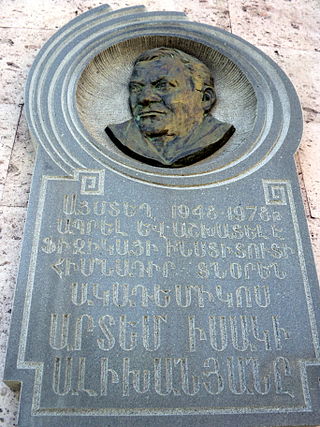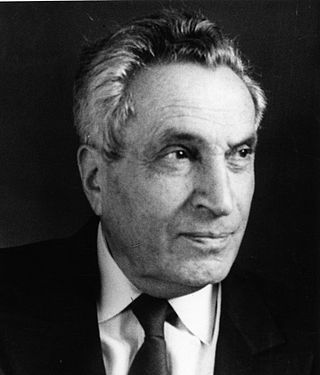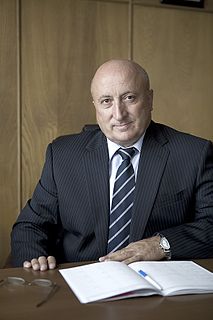Related Research Articles

The Armenian Soviet Socialist Republic, also commonly referred to as Soviet Armenia or Armenia was one of the constituent republics of the Soviet Union in December 1922 located in the South Caucasus region of Eurasia. It was established in December 1920, when the Soviets took over control of the short-lived First Republic of Armenia, and lasted until 1991. Historians sometimes refer to it as the Second Republic of Armenia, following the demise of the First Republic.

Viktor Amazaspovich Ambartsumian was a Soviet Armenian astrophysicist and science administrator. One of the 20th century's top astronomers, he is widely regarded as the founder of theoretical astrophysics in the Soviet Union.

Mikayel Nalbandian was a Russian-Armenian writer, poet, political theorist and activist.

Yerevan State University, also simply University of Yerevan, is the oldest continuously operating public university in Armenia. Founded in 1919, it is the largest university in the country. It is thus informally known as Armenia's "mother university". Of its 3,150 employees, 1,190 comprise the teaching staff, which includes 25 academicians, 130 professors, 700 docents, and 360 assistant lecturers. The university has 400 researchers, 1,350 post-graduate students, and 8,500 undergraduates, including 300 students from abroad.

Karen Serobi Demirchyan was a Soviet and Armenian politician. He served as the First Secretary of the Communist Party of Armenia from 1974 to 1988. Soon after his reemergence into active politics in independent Armenia in the late 1990s, he became President of the National Assembly in 1999 until his assassination with other politicians in parliament in the Armenian parliament shooting.

Alexander Tamanian was a Russian-born Armenian neoclassical architect, well known for his work in the city of Yerevan.

Sergey Mergelyan was a Soviet Armenian mathematician, who made major contributions to the Approximation Theory. The modern Complex Approximation Theory is based on Mergelyan's classical work. Corresponding Member Academy of Sciences of USSR, member of NAS ASSR.

Hakob Sanasaryan is a leading Armenian environmental activist, author and biochemist, the cofounder of the one of the first environmentalist groups in the former Soviet Union: Goyapahpanutyun in 1985. This group was later in 1989 coined in the press as the Greens Union of Armenia (GUA). Hakob Sanasaryan is to this day the president of the GUA.

Leonid Rubeni Azgaldyan was an Armenian physicist who rose to prominence as a military leader during the First Nagorno-Karabakh War. He is best known as one of the founders and commander of a large special operations force known as the Liberation Army.

The Armenian community in Argentina is the largest in Latin America totaling approximately 120,000 members.

Artyom Isaakovich Alikhanian was a Soviet and Armenian physicist, one of the founders and first director of the Yerevan Physics Institute, a correspondent member of the Academy of Sciences of the Soviet Union (1946), academic of the Armenian National Academy of Sciences. With Pyotr Kapitsa, Lev Landau, Igor Kurchatov, Abram Alikhanov and others, he laid the foundations of nuclear physics in the Soviet Union. He is known as the "father of Armenian physics".

Foreign relations exist between Armenia and Portugal. Neither country has a resident ambassador. Armenia is represented in Portugal through its embassy in Rome (Italy). Portugal is represented in Armenia through its embassy in Moscow. In addition Portugal is represented in Armenia through its honorary consulate on Nalbandyan street in Yerevan. The consul is Mr. Samuel Samuelyan.

Yuri Tsolakovich Oganessian is a Russian-Armenian nuclear physicist who is considered the world's leading researcher in superheavy chemical elements. He led the discovery of many elements in the periodic table. He succeeded Georgy Flyorov as director of the Flerov Laboratory of Nuclear Reactions at the Joint Institute for Nuclear Research in 1989 and is now its scientific leader. The heaviest element known in the periodic table, oganesson, is named after him, only the second time that an element was named after a living person.

Aram Bagrati "Bagratovich" Nalbandyan was a Soviet Armenian physicist, prominent in the field of physical chemistry, founder of the Institute of Chemical Physics in Yerevan, Armenia, and academician-secretary of the Chemical Department of the Armenian Academy of Sciences (AS). He is the author of more than 400 scientific articles and five monographs.

Diplomatic relations exist between Armenia and Mexico. Both nations are members of the United Nations.

Arpenik Nalbandyan was a Soviet-Armenian artist.

Sedrak A. Sedrakyan is an Armenian psychologist, doctor of Psychological Sciences, and professor.

Armenia–Spain relations refer to bilateral relations between Armenia and Spain. The importance of relations centers on the history of Armenians migration to Spain. Approximately 40,000 Armenians and their descendants reside in Spain. Both nations are members of the Council of Europe.
Rafael Papayan was a philologist, political prisoner, human rights activist, writer and a judge on the Constitutional Court of Armenia.
References
- ↑ The 50 Year Scientific Pathway. H. BUNIATIAN INSTITUTE OF BIOCHEMISTRY. p. 87.